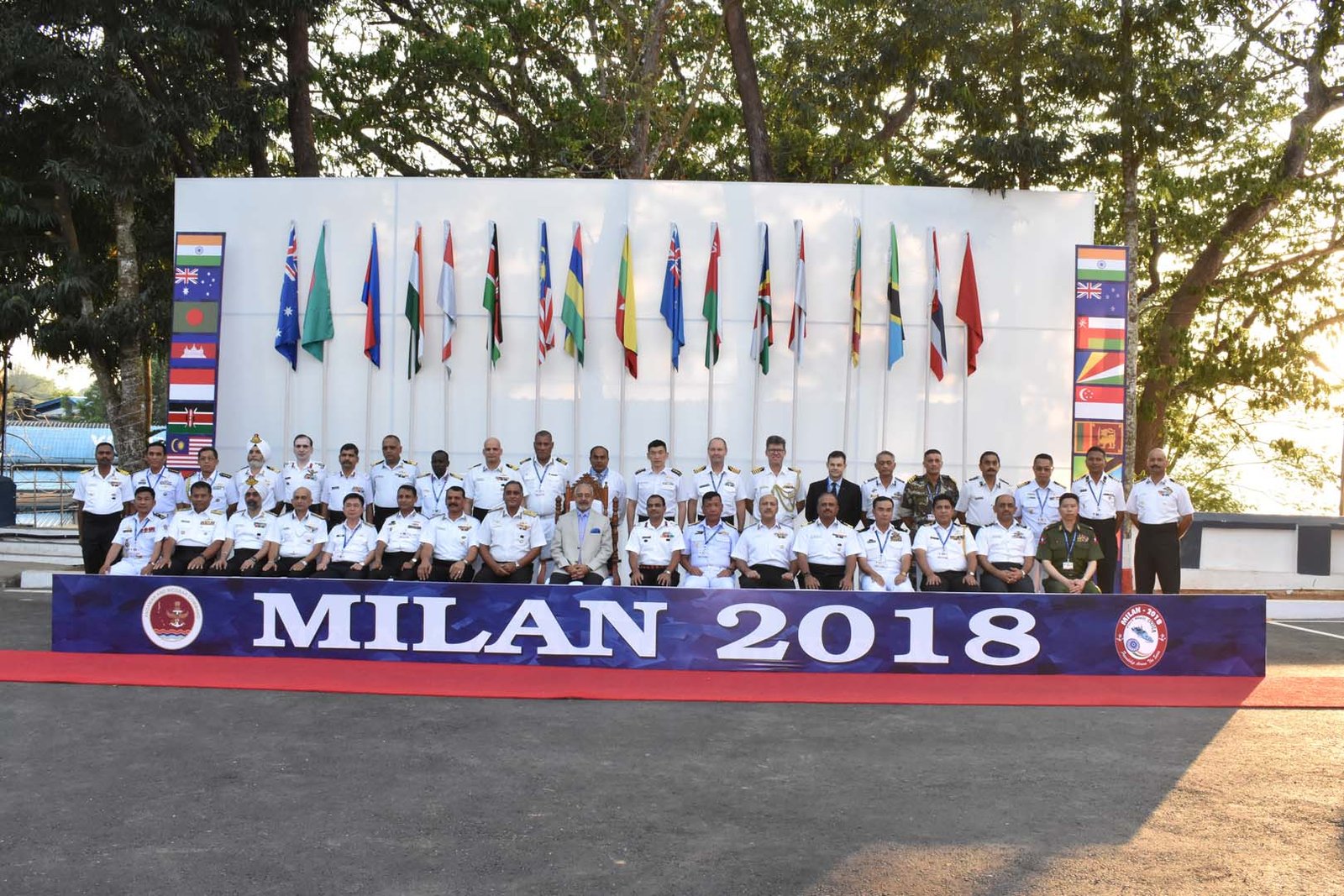MILAN 2018 was held at Port Blair from 06 March to 13 March 2018. MILAN 2018 was hosted in the beautiful Andaman & Nicobar Islands of India which is home to India’s unified Military Command, the Andaman and Nicobar Command (ANC). With the underlying theme of ‘Friendship across the Seas’, MILAN2018 witnessed a diverse mix of professional exercises and seminars, social events and sporting fixtures. MILAN has evolved from an initiative of the Indian Navy in the early nineties which aimed to create a forum for the littoral Navies of the Indian Ocean region to exchange thoughts in maritime cooperation and ‘Humanitarian Assistance and Disaster Relief’ (HADR). MILAN is an effective platform for social, cultural and professional interactions and promoting maritime cooperation as well as inter-operability during humanitarian missions.
The interactions during MILAN 2018 encompassed sharing of views and ideas on maritime order and enhancing regional cooperation for combating unlawful activities at sea. MILAN is a congregation of littoral navies which is being conducted biennially by Indian Navy at the Andaman and Nicobar Islands, under the aegis of the Andaman and Nicobar Command. Besides fosteringco-operation through naval exercises and professional interactions, MILAN also provides an excellent opportunity to the participating navies to come together in a spirit of collaboration and mutual understanding to nurture stronger ties.
MILAN made modest beginnings more than two decades ago when it was first held in 1995. The first MILAN was held in 1995 with five participating nations; India, Indonesia, Singapore, Sri Lanka and Thailand. Since then the event has been held every two years except in 2001, 2005 and 2016.
The 10th edition of Milan this year was concluded with Milan Exercise Sea (MILES), conducted from 11 to 13 March 2018, which saw participation of 28 warships including 17 from India and 11 from Australia, Bangladesh, Indonesia, Malaysia, Myanmar, Singapore, Sri Lanka and Thailand participating in the exercise and thus making it the largest multilateral exercise to be conducted in the Andaman Sea. Maldives, which is reeling under political crisis, had declined India’s offer to participate at the exercise citing the current situation in the island nation. The aim of MILAN 2018 exercise was to enhance interoperability between navies of the region and to exchange best practices. Weapon firing, Search and Rescue operations, Air Defence exercises, Cross-deck flying, Boarding Operations and Medical Evacuation drills were conducted during the exercise. The foreign ships participating in the exercise include, HMAS Larrakia of Australia, BNS Dhaleshwari of Bangladesh, KRI Cut NyakDien and Lemadang of Indonesia, KD Lekiu of Malaysia, UMS Inlay and King Sin Phyu Shin of Myanmar, RSSD auntless of Singapore,S LNS Samudura and Suranimala of Sri Lanka and HTMS Narathiwat of Thailand. The Indian ships participating in the exercise include INS Sahyadri, Jyoti, Kirch, Kulish, Saryu, Kesari, Baratang and Bangaram and INLCUL51.
The successive editions of MILAN have witnessed the participation of littoral navies of the Indo-Pacific region. The MILAN event has achieved strident succession recent years owing to high standards of professional content of the event. The growing participation over the years bears testimony to the success of this multilateral initiative in the maritime domain of Indo-Pacific region. From an event of sub- regional context earlier, MILAN has now grown into a prestigious international event and encompasses participation by maritime forces from not just the Bay of Bengal and South East Asia but the larger Indian Ocean Region (lOR).
Geostrategic significance of Indian Ocean and role of MILAN in fostering the relations among navies of Indian Ocean Region:
MILAN exercise also highlights the Geo-strategic significance of the Indian Ocean Region. In the Geo-political context of this naval exercise , we also need to look into the India’s approach and strategy towards the Indian Ocean Region. India is essentially a maritime nation and the Indian Ocean has been at the vortex of intense maritime activity over centuries. The last two decades has witnessed substantial expansion in India’s dependence on her maritime environment. The Indian Ocean Region, which is an area of primary interest for the Indian Navy, has also emerged as the world’s center of gravity in the maritime domain. The MILAN exercise truly sums up the evolving dynamics in the Indian Ocean Region and encapsulates India’s maritime approach.
A unique factor which differentiates the Indian Ocean from the other two major oceans–the Pacific and the Atlantic–is that almost 80% of the oil and trade that emanates in the Indian Ocean Region is extra-regional in nature. It implies that any impediment to the free movement of oil or trade through the Indian Ocean Region, will have an impact not just on the economies of the region, but the rest of the global economy as well. It is in the Indian Ocean Region where interests of the rim countries, as well as major Geo-political entities like US and Chinaetc intersect. The Indian Ocean has therefore become a cross-road of geopolitical dynamics in context of rising economies of China and India and their increasing dependence on the maritime trade along with other countries in the region. These characteristics of the Indian Ocean Region underscore its maritime nature, and point to the need for maintaining stable, secure and safe seas and MILAN naval exercise has certainly helped in building the capacity and interoperability among various nations in the region.
Under the broad framework of MILAN naval exercise, Indian Navy has initiated a series of capacity building and capability enhancement initiatives to establish an environment of peace and stability in the Indian Ocean Region. Such initiatives have certainly strengthened the capacity of the partner navies in order to provide maritime security in its own area of operation, and thus has helped in improving net security in the regional maritime environment as well as strengthening bilateral relations and maritime interoperability. The capability enhancement initiatives of the Indian Navy under MILAN exercise include measures for cooperative development through training, technical support and maintenance and hydrographic cooperation.
Through MILAN, India has aimed to shape a favorable and positive regional maritime environment in the Indian Ocean region with similar, like-minded endeavors of other regional partners. Through MILAN, India has given a clear signal that in order to strengthen the global maritime partnerships and networking amongst the navies of the new order in the 21st century, there is an urgent need to address common maritime threats and challenges. It is a fact that stability in a well-networked and interdependent maritime domain is the shared responsibility of coastal states. MILAN can be helpful in achieving such objectives through synergized, inclusive and cooperative efforts facilitated by maritime engagements.
In future also through MILAN naval exercise, India should try to continue to operate in cooperation with friendly maritime forces in the Indian Ocean Region to address shared security concerns, and look towards promoting peace, security and stability in the maritime neighborhood, through open, transparent, inclusive, balanced and cooperative measures. This forms the basis and the core of India’s strategy and approach to the Indian Ocean Region.





Excellent that Milan functions well in its continuance over 23 yrs and has built up a proud record of owning its firm stand of presence with a purpose.